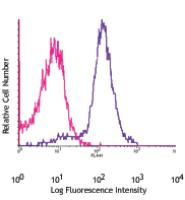-
Sign In
-

-
 Sony Biotechnology
Sony Biotechnology
-

-
 Sony Biotechnology
Sony Biotechnology
Alexa Fluor® 647 anti-Bcl-2
Antibodies Single
Sony
BCL/10C4
Flow Cytometry
Mouse IgG1, κ
Mouse,Rat
N-terminal, Amino acid residues 61-76 of mouse Bcl-2
3767545
$128.00
Description
Bcl-2 (B-cell leukemia 2) is an apoptotic protein and a member of the Bcl-2 family containing BH1-4 domains. Two reported isoforms exist α=25 kD; β=22 kD. The Bcl-2 protein forms homo- or hetero-dimers with other Bcl-2 family members. Bcl-2 is distributed in the outer mitochondrial membrane, the nuclear envelope, and the endoplasmic reticulum. This protein blocks apoptotic death by controlling mitochondrial membrane permeability. Cleavage of Bcl-2 can convert to pro-apoptotic (by cleavage of BH4 domain). Bcl-2 has been reported to regulate cell cycle progression via ROS. This protein is modified by ASK1/JNK1, PKC, ERKs, and stress-activated kinase phosphorylation and can be ubiquitinated. Bcl-2 has been shown to interact with Apaf-1, Raf-1, TP53BP2, caspase-3, and form heterodimers with Bax, Bad, Bak, Bcl-xL, and Bag-1. Clone BCL/10C4 has been shown to be useful for Western blotting, immunoprecipitation, and immunofluorescence of the mouse and rat Bcl-2 protein.
Formulation
Phosphate-buffered solution, pH 7.2, containing 0.09% sodium azide.Recommended Usage
Each lot of this antibody is quality control tested by intracellular immunofluorescent staining using our nuclear factor staining protocol. For flow cytometric staining, the suggested use of this reagent is ≤ 1.0 microg per 106 cells in 100 microL volume. It is recommended that the reagent be titrated for optimal performance for each application.
* Alexa Fluor® 647 has a maximum emission of 668 nm when it is excited at 633nm / 635nm.


